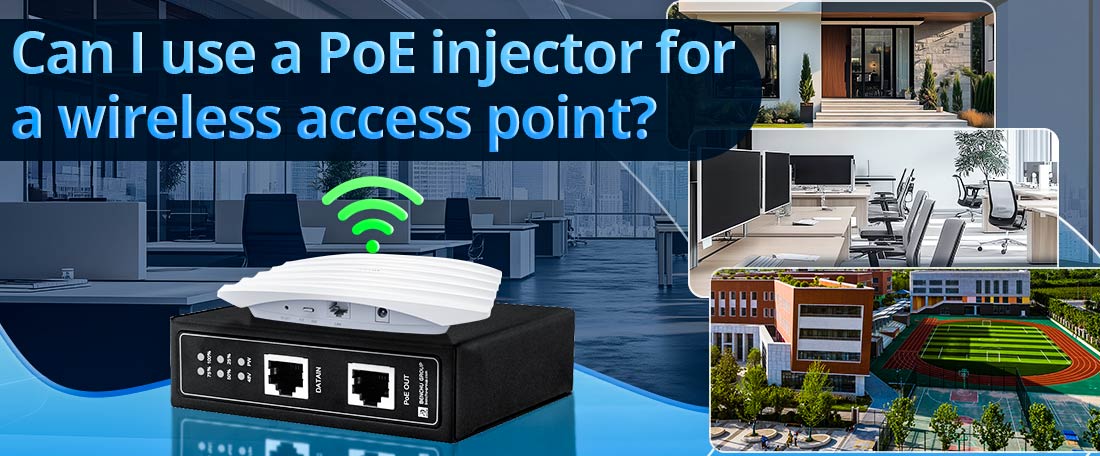
Sim, você pode usar um injetor PoE para alimentar um ponto de acesso sem fio (WAP). Os injetores PoE são uma solução eficaz para fornecer energia e dados aos WAPs por meio de um único cabo Ethernet. Esta configuração é especialmente útil em locais onde o acesso às tomadas elétricas é limitado ou quando um switch habilitado para PoE não está disponível.
Aqui está uma explicação detalhada de como os injetores PoE funcionam com WAPs, seus benefícios e o que você precisa considerar:
1. Como funcionam os injetores PoE com pontos de acesso sem fio
Integração de energia e dados: A Injetor PoE combina dados da sua rede (por exemplo, um roteador ou switch não PoE) com energia de uma fonte de alimentação externa e envia ambos através de um cabo Ethernet para o WAP.
Etapas de conexão:
--- Conexão de rede: Conecte a porta de entrada/rede de dados do injetor PoE ao roteador ou switch usando um cabo Ethernet.
--- Conexão WAP: Conecte a porta de saída PoE do injetor PoE ao WAP usando outro cabo Ethernet.
--- Fonte de alimentação: Conecte o injetor PoE a uma tomada CA.
--- Uma vez conectado, o WAP recebe energia e dados pelo cabo Ethernet, permitindo fornecer conectividade sem fio.
2. Benefícios de usar um injetor PoE para WAPs
um. Instalação simplificada
--- Solução de cabo único: Um único cabo Ethernet fornece energia e dados, reduzindo a confusão de cabos e simplificando o processo de instalação.
--- Elimina a necessidade de tomadas elétricas próximas: Isso é especialmente benéfico para WAPs montados no teto ou instalações externas onde o acesso a tomadas elétricas é limitado.
b. Solução econômica
--- Um injetor PoE é uma opção mais acessível do que investir em um switch habilitado para PoE, especialmente para configurações que envolvem um ou dois WAPs.
c. Flexibilidade na colocação
--- Os injetores PoE permitem que os WAPs sejam instalados em locais ideais para cobertura sem fio, independentemente da disponibilidade da tomada elétrica.
d. Fornecimento de energia de longa distância
--- Energia e dados podem ser transmitidos até 100 metros (328 pés) usando cabos Ethernet Cat5e ou Cat6, permitindo a implantação de WAPs em áreas remotas ou de difícil acesso.
e. Compatibilidade
--- Os injetores PoE são compatíveis com a maioria dos WAPs que suportam padrões PoE, incluindo IEEE 802.3af (PoE), 802.3at (PoE+) e 802.3bt (PoE++).
3. Tipos de pontos de acesso sem fio que podem usar injetores PoE
--- Pontos de acesso sem fio padrão: Ideal para redes domésticas e de pequenos escritórios.
--- Pontos de acesso externos: os injetores PoE costumam ser combinados com WAPs classificados para ambientes externos para fornecer conectividade em áreas externas, como parques ou campi.
--- WAPs de alto desempenho: Para WAPs de nível empresarial, incluindo aqueles com vários rádios ou recursos avançados, podem ser necessários injetores PoE de alta potência (por exemplo, 802.3at ou 802.3bt).
4. Principais considerações
um. Requisitos de energia do WAP
Verifique os requisitos de energia do WAP e certifique-se de que o injetor PoE suporta o padrão necessário:
--- 802.3af (PoE): Fornece até 15,4 W, suficiente para WAPs padrão.
--- 802.3at (PoE+): Fornece até 25,5 W, adequado para WAPs com recursos avançados ou capacidades de banda dupla.
--- 802.3bt (PoE++): Fornece até 60 W ou 100 W, necessário para WAPs de alta potência como Wi-Fi 6E ou aqueles com vários rádios.
b. Qualidade e comprimento do cabo
--- Use cabos Ethernet Cat5e ou Cat6 de alta qualidade para garantir energia eficiente e transmissão de dados.
--- Mantenha o comprimento total do cabo dentro do limite de 100 metros (328 pés) para manter o desempenho.
c. Condições Ambientais
Para WAPs externos:
--- Use um injetor PoE à prova de intempéries ou guarde-o em um invólucro protetor.
--- Combine com cabos Ethernet para uso externo para suportar exposição UV, umidade e temperaturas extremas.
d. Capacidade de rede
--- Certifique-se de que seu roteador ou switch tenha largura de banda suficiente para suportar as necessidades de dados do WAP.
e. Proteção contra surtos
--- Considere a instalação de dispositivos de proteção contra surtos, especialmente para WAPs externos, para proteger contra picos de energia e raios.
5. Casos de uso específicos para injetores PoE com WAPs
um. Expandindo a cobertura Wi-Fi
--- Implante WAPs em áreas com sinal fraco para estender a cobertura sem fio em residências, escritórios ou espaços externos.
b. Retrofit de redes existentes
--- Se a sua infraestrutura de rede existente não tiver suporte PoE, um injetor PoE pode ser usado para alimentar WAPs sem substituir o switch ou roteador.
c. Implantações de Wi-Fi externas
--- Instale WAPs em locais externos, como campi, estádios ou instalações industriais, sem se preocupar com a disponibilidade de energia.
6. Vantagens sobre soluções alternativas
| Recurso | Injetor PoE | Interruptor PoE |
| Custo | Menor para configurações WAP únicas | Mais alto, melhor para vários WAPs |
| Complexidade de instalação | Simples | Requer configuração de switch habilitado para PoE |
| Flexibilidade | Ideal para reforma | Mais adequado para novas implantações |
| Escalabilidade | Limitado a um ou alguns WAPs | Suporta vários WAPs |
7. Conclusão
Um injetor PoE é uma excelente solução para alimentar pontos de acesso sem fio, especialmente em cenários onde um ou poucos WAPs estão sendo implantados ou quando switches habilitados para PoE não estão disponíveis. Ele simplifica a instalação, reduz os custos de infraestrutura e oferece flexibilidade para colocar WAPs em locais ideais. Ao garantir a compatibilidade com os requisitos de energia e condições ambientais do WAP, um injetor PoE pode alimentar seu WAP de maneira confiável, mantendo um forte desempenho da rede.